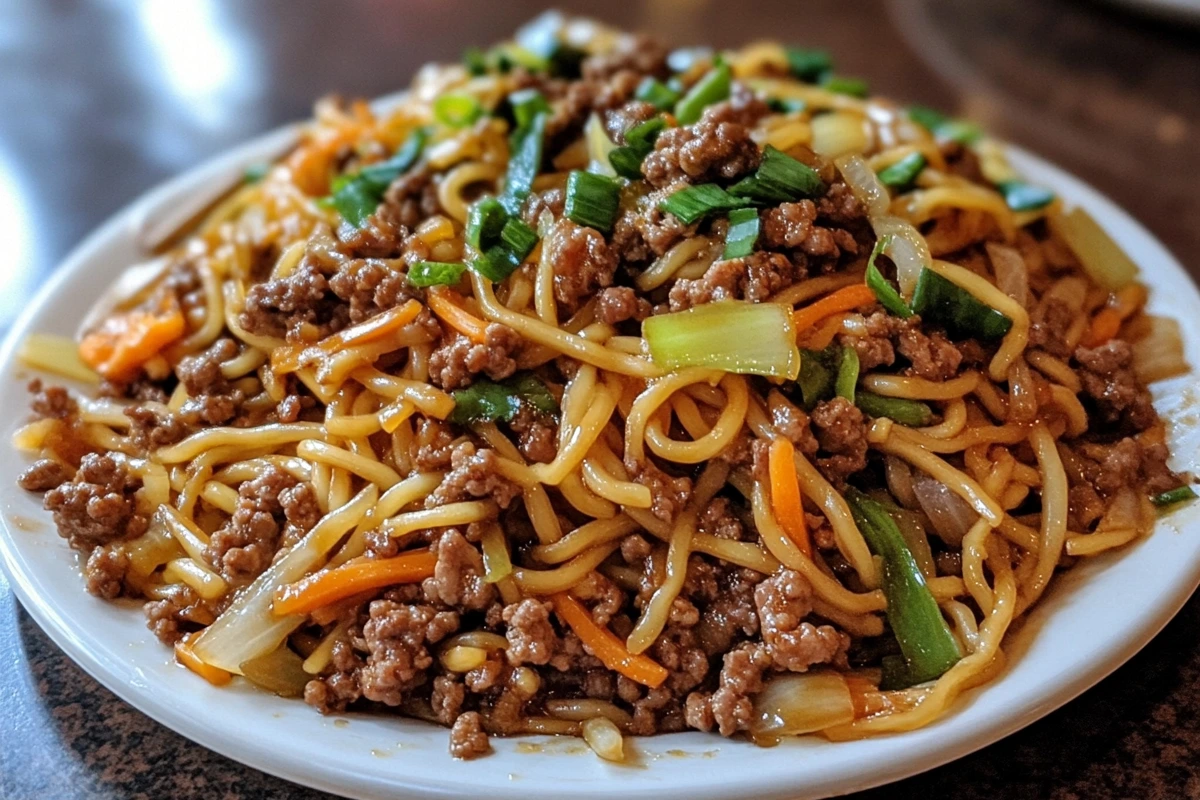
Introduction
Mongolian Ground Beef Noodles is a mouthwatering, quick, and easy recipe that combines the savory-sweet flavors of Mongolian cuisine with tender noodles and ground beef. It has a balance of spicy, sweet, and salty flavors, making it a favorite among Asian-inspired recipes. The recipe is perfect for busy weeknights, as it takes less than 30 minutes to prepare. In this article, we’ll dive into its origins, ingredients, variations, storage tips, and serving suggestions to help you perfect this flavorful dish at home.
History of Mongolian Ground Beef Noodles
Despite its name, Mongolian Ground Beef Noodles isn’t directly from Mongolia. Instead, it’s a popular dish in American-Chinese cuisine, often inspired by the flavors of Mongolian beef—a dish typically served with thinly sliced beef stir-fried with onions, scallions, and soy-based sauces. This recipe incorporates those flavors into a simple noodle dish with ground beef, making it more accessible and budget-friendly for home cooking.
Mongolian-inspired dishes gained popularity in American-Chinese restaurants during the mid-20th century. The use of soy sauce, ginger, garlic, and brown sugar provides a signature sweet-savory taste that has since been adapted into various forms, including this noodle-based version.
Essential Ingredients for Mongolian Ground Beef Noodles
To make a delicious batch of Mongolian Ground Beef Noodles, you will need the following ingredients:
- Ground Beef (1 lb): The star ingredient of this dish, it adds protein and richness. Substitutions: Ground chicken, turkey, or pork can be used for a lighter version.
- Noodles (8 oz): Opt for Asian-style noodles like udon, lo mein, or rice noodles. Substitutions: Spaghetti, fettuccine, or any other pasta works well.
- Soy Sauce (1/4 cup): Adds umami flavor. Substitutions: For a gluten-free option, use tamari or coconut aminos.
- Brown Sugar (1/4 cup): Adds sweetness, creating the signature sweet-savory balance. Substitutions: Honey or maple syrup can work as well.
- Ginger (2 tsp, minced): Adds warmth and depth. Substitutions: Ground ginger can be used, but fresh ginger is recommended for authenticity.
- Garlic (3 cloves, minced): Provides a robust, aromatic flavor.
- Sesame Oil (1 tbsp): Adds a nutty aroma to the dish. Substitutions: Olive oil or avocado oil can be used.
- Green Onions (for garnish): Adds a fresh, mild onion flavor.
- Red Pepper Flakes (optional): Adds a bit of heat for those who like it spicy.
Additional Ingredient Options:
- Vegetables: Broccoli, snap peas, carrots, or bell peppers can be added for extra nutrition.
- Sauces: Hoisin sauce, oyster sauce, or chili garlic sauce can be added for enhanced flavors.
- Herbs: Fresh cilantro or basil can add a fresh, herbal note.
Cooking Instructions: How to Make Mongolian Ground Beef Noodles
- Prepare the Noodles:
- Cook the noodles following the package instructions until they are al dente. Drain and set aside.
- Cook the Ground Beef:
- Heat sesame oil in a large skillet or wok over medium-high heat.
- Add the ground beef to the skillet and cook until browned and thoroughly cooked, breaking it into small crumbles as it cooks. Drain excess fat if needed.
- Add Aromatics:
- Add minced garlic and ginger to the cooked beef, sautéing for about 1-2 minutes until fragrant.
- Prepare the Sauce:
- In a small bowl, mix soy sauce, brown sugar, and a splash of water. Stir until the sugar is dissolved.
- Combine Everything:
- Pour the sauce into the skillet with the beef, stirring to coat.
- Add the cooked noodles to the skillet and toss until everything is well combined. Allow the noodles to soak up the flavors for 2-3 minutes.
- Adjust Seasonings:
- Taste and adjust the sauce by adding more soy sauce, brown sugar, or red pepper flakes to your preference.
- Garnish and Serve:
- Garnish with sliced green onions and serve hot!
Cooking Tips:
- Cook the noodles al dente: Slightly undercooking the noodles helps them absorb the sauce without becoming mushy.
- Sauté aromatics well: Ensure the ginger and garlic are well sautéed to bring out their full flavor before adding the sauce.
- Adjust sweetness: Taste the sauce and adjust the sweetness by adding more brown sugar or reducing it if you prefer less sweetness.
Variations of Mongolian Ground Beef Noodles
- Spicy Version: Add more red pepper flakes, sriracha, or a splash of chili oil to give the dish a spicy kick.
- Low-Carb Option: Swap regular noodles for zoodles (zucchini noodles) or shirataki noodles to reduce carbs.
- Vegetarian/Vegan Version: Use plant-based ground meat alternatives like tofu, tempeh, or mushroom crumbles.
- Gluten-Free Option: Use rice noodles and tamari instead of soy sauce for a gluten-free adaptation.
- Add Veggies: Incorporate vegetables like bok choy, spinach, or shredded carrots to make it more nutritious.
- Alternative Proteins: Ground turkey, chicken, or pork can be used instead of ground beef for different flavors.
Storage and Reheating Tips
- Storage: Place leftover noodles in an airtight container and store them in the refrigerator for up to 3 days.
- Freezing: The dish can be frozen for up to 1 month. Allow it to cool completely before freezing.
- Reheating: Reheat the noodles in a skillet over medium heat with a splash of water or soy sauce to moisten them. Alternatively, microwave for 2-3 minutes, stirring halfway.
Serving Suggestions
Mongolian Ground Beef Noodles pairs well with a variety of side dishes. Here are some ideas:
- Steamed Rice: For extra carbs, serve with a side of steamed jasmine or basmati rice.
- Egg Rolls: Crispy egg rolls make a perfect appetizer or side dish.
- Asian Slaw: A refreshing side salad with cabbage, carrots, and sesame dressing balances the flavors.
- Kimchi: Adds a spicy, tangy contrast to the sweet-savory noodles.
- Sautéed Greens: Lightly sautéed spinach, bok choy, or Chinese broccoli is a nutritious side option.
Health Benefits of Mongolian Ground Beef Noodles
Mongolian Ground Beef Noodles, when prepared with mindful ingredients and portion control, can offer several health benefits:
1. Rich Source of Protein
- Ground Beef provides a good amount of protein, essential for muscle growth, repair, and overall body strength. Protein also helps keep you fuller for longer, aiding in satiety and reducing hunger cravings.
- Using lean ground beef (90% lean or higher) reduces the fat content, making it a healthier protein option.
2. High in Nutrients
- Beef is packed with important nutrients like iron, zinc, and B vitamins (B6 and B12), which are essential for red blood cell production, immune function, and energy metabolism.
- Ginger and Garlic in the recipe not only enhance the flavor but also provide anti-inflammatory and antioxidant benefits, supporting overall health and immunity.
3. Balanced Carbohydrates
- The noodles provide carbohydrates, which are the body’s primary energy source. When paired with a protein source like beef, they create a well-rounded meal that helps maintain steady energy levels.
- Opting for whole wheat or rice noodles can boost the fiber content, supporting digestive health and providing longer-lasting energy.
4. Low in Added Sugars (if Modified)
- By controlling the amount of brown sugar in the sauce, you can reduce the added sugar content, making it healthier. The sweetness can be balanced with natural substitutes like honey or a smaller amount of brown sugar for those looking to cut back on sugar intake.
5. Nutritious Add-Ins
- Adding vegetables like broccoli, snap peas, carrots, or bell peppers increases the fiber, vitamins, and mineral content of the dish. This not only enhances the nutritional profile but also adds color, texture, and flavor variety.
6. Heart-Healthy Fats
- Sesame oil, used in the recipe, contains heart-healthy monounsaturated and polyunsaturated fats, which support cardiovascular health. Consuming moderate amounts of healthy fats can help reduce bad cholesterol levels, improving heart function.
7. Boosts Immune System
- The garlic, ginger, and green onions used in the recipe are packed with antioxidants and antimicrobial properties, which help strengthen the immune system. Regular consumption of these ingredients can help reduce the risk of infections and support overall wellness.
8. Customizable for Dietary Needs
- You can make this recipe low-carb by swapping the noodles for zoodles (zucchini noodles) or shirataki noodles. Similarly, using gluten-free noodles or tamari ensures a gluten-free version, accommodating dietary restrictions without compromising on flavor.
FAQs
1. Can I make this dish spicy?
Yes, add more red pepper flakes, sriracha, or chili oil to the sauce.
2. Can I use other types of noodles?
Yes, you can use any type of noodles, such as udon, lo mein, rice noodles, or even pasta.
3. Is it possible to make this recipe gluten-free?
Yes, substitute soy sauce with tamari and use gluten-free noodles or rice noodles.
4. Is it possible to make this dish in advance?
Yes, you can prepare the sauce and ground beef ahead. Prepare the noodles right before serving to keep their texture firm and enjoyable.
5. What’s the best way to keep the noodles from becoming soggy?
Cook the noodles al dente and add them to the sauce right before serving.
Conclusion
Mongolian Ground Beef Noodles is a versatile, delicious, and easy-to-make dish that brings the bold flavors of Mongolian-inspired cuisine to your home. This dish offers a wonderful blend of savory, sweet, and spicy flavors that can be tailored to your preferences. Whether you’re making it for a quick family dinner or prepping for meal planning, this recipe is sure to be a hit. Try it today and discover why it’s a favorite among Asian-inspired dishes!

